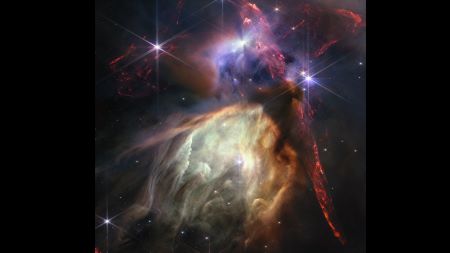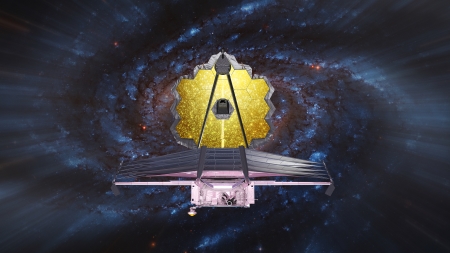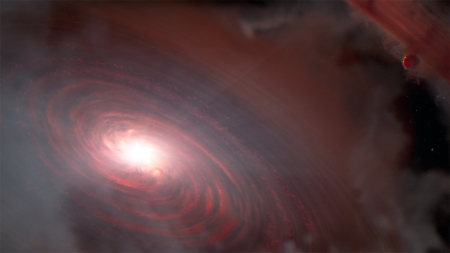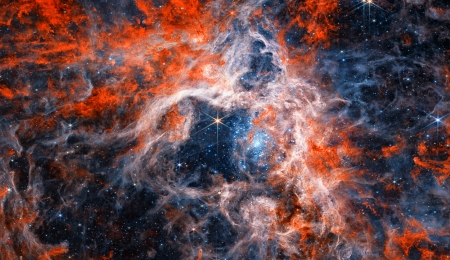“Telescope Finds Water in Space” should have been huge news blasted on every headline recently. However, the accomplishments of the James Webb Telescope are often underplayed and underappreciated. This ER Optics blog will attempt to remedy that.
We often report on the James Webb telescope. It is a magnificent accomplishment for humanity, and it would be impossible without technology such as ours.
Therefore, we have been following its story since it was first launched into deep space–further and deeper than any previous exploratory probe or telescope.
Before reading this article, you might like to review one of our previous articles about the James Webb Telescope.
Telescope Finds Water and More in Space on Anniversary Month

From a Quiet Nebula in Space, See the Birth of a Star. (Actually the First Anniversary Image.) Webb Telescope Displayed the Rho Ophiuchi Cloud Complex. (This is the Closest Star-Forming Region to Earth. Naturally, It’s Called the Star Nursery.)
Perhaps you already know that this week marked the first year anniversary of the James Webb telescope. We are not celebrating its launching, but its transmitting. After launch, the telescope had to unfurl its giant protective shield and adjust its array of technological instruments. Finally, after extensive adjustments, we first began receiving transmissions of images on August 24 of last year.
Telescope Finds Water in the First Year of Its Journey
On its mission to discover how galaxies form, age, and die, the James Webb telescope has sent us many images from millions of miles in deep space. We’d never accuse this fabulous array of scientific instruments of showing off to celebrate its anniversary. However, coincidentally, it made an amazing discovery just one day into its anniversary year.
How a Telescope Finds Water in Space

We Thought You Would Like to Know How the Webb Telescope Finds Invisible Wave Lengths of Light And Translates them Into Color? These Are Created From Gas Jets From a New Born Star.
No, it did not find an ocean on a nearby planet, but it did find water vapor only 100 million miles from the distant star known only as PDS 70. Below, find a description of its discovery:
1. Imagine a huge photodisk of a spiraling galaxy forming deep in space.
2. Then focus on two rocky protoplanets that are forming. This is the active area of “a galaxy far, far away,” where the James Webb telescope astonishingly discovered water vapor.
3. NASA reported, “This is the first detection of water in the terrestrial region of a disk already known to host two or more protoplanets…”
Other Webb Telescope Skills
And, the James Webb telescope not only detected and reported it but also sent us an amazing image of it.
The protoplanets look like little stars hatching in a misty sea, NASA explained. “The finding shows that a water reservoir is available for terrestrial planets that might be coalescing there.”
Going back in Time to Discover Our Oldest Galaxies

Note the Stormy or Misty Appearance of This Image. This is Water Vapor. Moreover, It Could Be Part of a Planet Forming in a Galactic “Star Nursery.”
The James Webb telescope intends to find the secrets of the forming of our universe. Now it has seen how stars are born, and how universes die. Finding water in space is significant because, in the words of NASA, “Water is essential for life as we know it.”
The True Mystery Behind Finding the Water
The telescope finding water in space helps to settle an argument long discussed by scientists.
- They have long wanted to know how water reached our earth.
- Likewise, they are very curious about “whether the same processes could seed rocky exoplanets orbiting distant stars.”
- Now, they believe they might answer these questions because of the new data sent by the Webb Telescope.
- Keep in mind that the PDS 70 planetary system is 370 light-years from Earth.
What Else Did the Telescope Find?
Thanks to the Webb telescope, we know this star supports an inner disk of galactic matter and an outer disk containing gasses and dust.
The two disks of this galaxy are “separated by a 5 billion-mile-wide (8 billion kilometers) gap…” The interesting part of this gap is that we now know it supports two known gas-giant planets.
Where Did the Telescope Find Water?
Since NASA’s James Webb Space Telescope possesses a MIRI (Mid-Infrared) Instrument, we now know there is water vapor located specifically in the system’s inner disk.
As stated above, the spiral of the inner disk operates at distances of less than 100 million miles or 160 million kilometers from the star. For reference, you might remember, “The Earth orbits 93 million miles from our Sun.”
Congratulations For the Telescope
Giulia Perotti of the Max Planck Institute for Astronomy (MPIA) in Heidelberg, Germany stated, “We’ve seen water in other disks, but not so close in and in a system where planets are currently assembling.” She added, “We couldn’t make this type of measurement before Webb…”
Terrific Take-Aways from Telescope Finds Water

The Carina Nebula Region in Deep Space is Invisible to Earth-Bound Telescopes. The “Red” Gasses Are Red to Our Perception. However, They are Actually Invisible. Thus, the Webb Telescope Turns Them Red So Our Eyes Can See Them.
FMPIA director Thomas Henning, co-principal investigator of Webb’s MIRI (Mid-Infrared Instrument), declared, “This discovery is extremely exciting, as it probes the region where rocky planets similar to Earth typically form.”
Indeed, we find such discoveries from millions of miles into space to be amazing. For generations, people have wondered how stars form and planets thrive.
The James Webb Telescope is prying open the secrets of the universe. Mysterious Hint: Find out more about PDS 70 and the secrets of silicates in our next blog, Part Two of Webb Telescope Finds Water—and much more.


